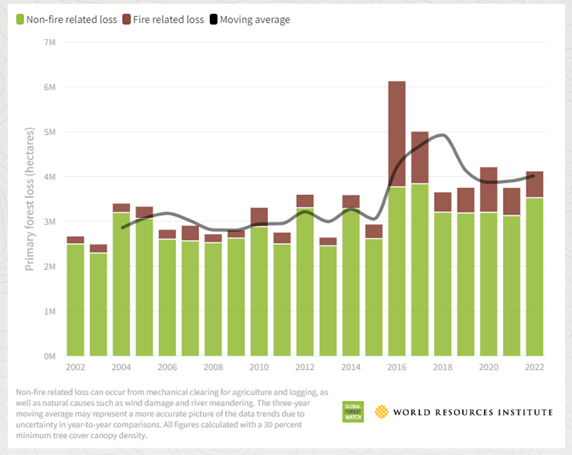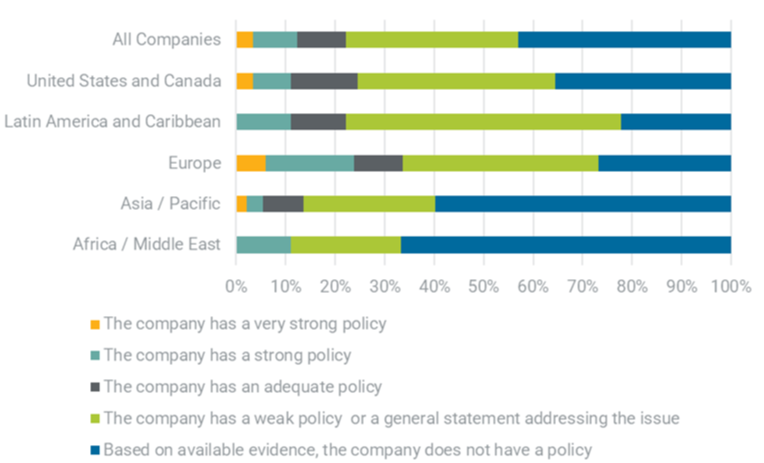Every year, deforestation costs the world between US$2 trillion and US$4.5 trillion, due to the declining value of ecosystem services.1 Forests are home to more than 80% of terrestrial biodiversity and over 25% of the global human population's livelihood depends on forests.2 Forests provide extensive resources and essential services to the world, but they are under threat globally. Research shows that two-thirds of original rainforests are either lost or degraded, where agricultural expansion continues to be the key driver of deforestation.3 Although the focus on preventing deforestation started decades ago, tropical primary forest loss continues up to this day where the amount of forest lost between 2021 and 2022 rose 10% (see Figure 1).4 Despite ambitions to reverse forest loss as outlined in the UN Strategic Plan for Forests in 2017 and the Glasgow Leaders’ Declaration on Forests and Land Use at COP 26, the world is still far from achieving zero deforestation.
Figure 1. Tropical Primary Forest Loss, 2002-2022

Source: World Resources Institute, 2023. For informational purposes only.
Financial institutions are uniquely placed to influence commodity-driven deforestation and land conversion through their financing activities. A recent report estimates that one Dutch bank’s financing of high-forest-risk sectors (i.e., beef, soy and pulp and paper) in Brazil from 2000 to 2022 had a societal cost estimated at EUR 66 billion. This cost is not solely calculated on the balance sheet, but is rather externalized to society as a result of the loss of the intrinsic value of nature, the increase in greenhouse gas (GHG) emissions, and the worsening of health and livelihood. The number is even more staggering when compared to the estimated profit for the same 22-year period: just EUR 0.7 billion.5
Investors have a role to play in combatting commodity-driven deforestation. By constructing portfolios using comprehensive risk assessments and robust deforestation and land conversion strategies, investors can contribute to not only preserving forests and associated ecosystem services, but ultimately protecting global economic wealth. Three reasons for why investors must pursue zero deforestation portfolios are explored further below.
Reason One: Portfolios Can’t Achieve Net Zero Without Tackling Deforestation
Forests play a leading role in counteracting global warming. They are the second largest storehouse of carbon6 and contribute to climate change mitigation and adaptation strategies. By the numbers:
- Commodity-driven deforestation is responsible for 70% to 90% of forest degradation or loss.7,8 To tackle deforestation, we must address it.
- The global food system is responsible for one quarter of overall GHG emissions. Associated land use accounts for 24% of food emissions due to the conversion of forests, savannah burning and so on for agricultural uses.9
- More than 90% of forest, land and agriculture (FLAG) companies could fail to achieve net-zero climate commitments due to insufficient action on deforestation.10
To address these issues, investors are engaging with FLAG companies to highlight the importance of reducing GHG emissions from land-use change and to push for a more robust deforestation risk management strategy. Investors cannot ignore the challenges and opportunities in the FLAG sectors, and engaging directly with companies can reinforce the message and help to move portfolios closer to net-zero emissions.
Reason Two: Unmanaged Transition Risk Within Portfolios Can Lead to Financial Penalties
The new European Union regulation on deforestation-free products (EUDR) is a groundbreaking deal to halt deforestation. It may inspire other jurisdictions to follow suit. Companies failing to comply with EUDR may receive fines of up to 4% of the company’s EU revenue, be temporarily excluded from public procurement processes, and be prohibited from dealing in the EU.11
According to Morningstar Sustainalytics’ ESG Risk Ratings assessment, only 22% of companies from sectors that directly or indirectly contribute to deforestation have at least an adequate deforestation policy, with only 12% having strong policies in place (see Figure 2). To comply with the EUDR, which comes into effect December 30, 2024, most companies must strengthen their forestry-related commitments to eliminate the risk of financial loss.
Figure 2. Strength of Companies' Deforestation Policies by Region

Source: Morningstar Sustainalytics. For informational purposes only.
Note: The data for this analysis was retrieved on the November 6, 2023 from Sustainalytics’ Ratings+ Universe and includes 365 companies from the following industries: Food Products, Food Retailers, Consumer Services, Consumer Durables, Household Products and Retailing. Regional breakouts are according to Sustainalytics’ database.
From our engagements with producers of commodities at high risk of contributing to deforestation, we’ve observed two key triggers for pursuing deforestation-free products: 1) demands from downstream companies and 2) regulatory enforcement. For the former, we’ve seen that demand for deforestation-free products from downstream companies provides the necessary incentives for commodity producers to change their practices. Therefore, engaging with the full agricultural value chain becomes an important tool for investors to address deforestation in their portfolios.
For the latter, the EUDR undoubtedly will shape supply chain practices. The regulation will impact smaller-scale companies with fewer resources to diversify their commodity sourcing and ensure their supply chain due diligence. It will also affect bigger players in the value chain with more complicated supply chains. Consequently, presenting engaged companies with best practices and accelerating their transition processes becomes important to mitigate such risk within investors’ portfolios.
Reason Three: Protecting Biodiversity Through Forest Health Can Bring Economic Benefits
The 2020 Nature Economy Report estimated that more than half of the world’s gross domestic product (over US$44 trillion) is moderately or highly dependent on nature and its services, yet biodiversity loss remains one of the top three global risks we face.12 Biodiversity’s alarming rate of decline threatens the global economy and exposes investors to an increasing risk of financial loss. Hence, conserving biodiversity by protecting forests can mitigate the identified global risk, and the preserved value of natural capital could generate new cash flow.
To tackle the two key drivers of biodiversity loss – the degradation of natural habitats and the unsustainable model of production and consumption – it is important to include forest protections and sustainable management in the Global Biodiversity Framework.13 Additionally, the finalization of the Taskforce on Nature-related Financial Disclosures (TNFD) framework is another milestone that could urge companies to assess their nature-related impacts and dependencies and implement a robust risk management system. By continuously engaging with high-forestry-risk companies on their forestry-related commitments and management, investors can help preserve the value and biodiversity of forests, ensuring the global economy’s dependency on it will not be disrupted.
The focus on deforestation prevention and reduction also brings economic opportunities for companies and investors. For instance, farmers have traditionally deforested to profit directly from commodities production and other economic activities on the deforested lands. However, in this value proposition, the worth of natural capital and ecosystem services are not weighted properly. The Dasgupta Review – an independent review on the economics of biodiversity published in 2021 – recommends changing the measures of economic success by introducing natural capital into national accounting systems.14
Taking this into consideration, a study by World Resource Institute Brasil suggests that ending deforestation will improve the Brazilian economy through job creation and GDP growth and contribute to the world’s climate change goals.15 Through active dialogues with companies, investors are more likely to seize the emerging opportunities to transition forestry risks into potential new profit sources.
How Investors Can Help Achieve Zero Deforestation
To systematically tackle deforestation in the global food system and beyond, collaboration across the value chain is key. Investors can come together to engage the companies in their portfolios and voice their concerns through company dialogues or by submitting proposals related to deforestation and conservation at companies’ annual general meetings. Together with global like-minded investors, Sustainalytics’ thematic engagements Climate Change – Sustainable Forests and Finance, Feeding the Future, and Biodiversity and Natural Capital Stewardship Programme engage with companies across the agricultural value chain to help reduce deforestation risk and contributes to decarbonization and biodiversity conservation. Through our engagements, companies are encouraged to follow global conventions and best practices to mitigate ESG risks within investors’ portfolios. For more information, please reach out via your preferred client advisory channel or send us an email.
References
- Osborn, J. 2023. “Forests Under Threat: A Comprehensive Look at the Latest Deforestation Statistics.” World Animal Foundation. (n.d.) https://worldanimalfoundation.org/advocate/deforestation-statistics/.
- WWF. Why Forests Are So Important. (n.d.) https://wwf.panda.org/discover/our_focus/forests_practice/importance_forests/.
- Krogh, A. “Only a third of the tropical rainforest remains intact.” Rainforest Foundation Norway. (n.d.) https://www.regnskog.no/en/news/only-half-of-the-worlds-rainforests-remains-intact.
- Weisse, M., Goldman, E., and Carter, S. “Forest Pulse: The Latest on the World’s Forests.” World Resources Institute. (n.d.) https://research.wri.org/gfr/latest-analysis-deforestation-trends.
- Rijk, G., Warmerdam, W., and Kuepper, B. 2023. “€ 0.7 billion in profits, € 66 billion in damages: Rabobank’s destructive financing of deforestation in Brazil.” Profundo Research & Advice. July 5, 2023. https://www.greenpeace.org/static/planet4-netherlands-stateless/2023/07/e70522eb-profundo_rabobank-brazil-final-july2023.pdf.
- World Wildlife Fund. Forests are key to cutting emissions and tackling the climate crisis. (n.d.) https://wwf.panda.org/discover/our_focus/forests_practice/forest_climate/.
- Pendrill, F., Persson, U M., Godar, J., and Kastner, T. 2019. “Deforestation displaced: trade in forest-risk commodities and the prospects for a global forest transition.” Environmental Research Letters. May 1, 2019. https://iopscience.iop.org/article/10.1088/1748-9326/ab0d41.
- World Benchmark Alliance. 2023. 2023 Nature Benchmark. https://www.worldbenchmarkingalliance.org/publication/nature/.
- Ritchie, H. 2019. “Food production is responsible for one-quarter of the world’s greenhouse gas emissions.” OurWorldInData.org. November 6, 2019. https://ourworldindata.org/food-ghg-emissions.
- “Why Net Zero Needs Zero Deforestation Now - Initial research paper from the UN Climate Change High-Level Climate Champions, Global Canopy, The Accountability Framework initiative, WWF and the Science Based Targets initiative.” June 2022. https://climatechampions.unfccc.int/wp-content/uploads/2022/06/Why-net-zero-needs-zero-deforestation-now-June-2022.pdf.
- Forwood, G., Connellan, C., Killick, J., and Nordin, S. 2023. “10 key things to know about the new EU Deforestation Regulation.” White & Case. July 21, 2023. https://www.whitecase.com/insight-alert/10-key-things-know-about-new-eu-deforestation-regulation.
- World Economic Forum. 2020. “Nature Risk Rising: Why the Crisis Engulfing Nature Matters for Business and the Economy.” World Economic Forum. January 2020. https://www3.weforum.org/docs/WEF_New_Nature_Economy_Report_2020.pdf.
- World Wildlife Fund. 2022. “Forests and the Global Biodiversity Framework: Expectations and must-haves.” World Wildlife Fund. December 1, 2022. https://wwf.panda.org/wwf_news/?7183416/Forests-and-the-Global-Biodiversity-Framework-Expectations-and-must-haves.
- “The Economics of Biodiversity: The Dasgupta Review – Headline Messages” Open Government. February 2021. https://assets.publishing.service.gov.uk/government/uploads/system/uploads/attachment_data/file/957629/Dasgupta_Review_-_Headline_Messages.pdf.
- World Resource Institute Brasil. 2023. “New Economy for the Brazilian Amazon.” World Resources Institute. June 2023. https://www.wri.org/research/new-economy-brazil-amazon.




